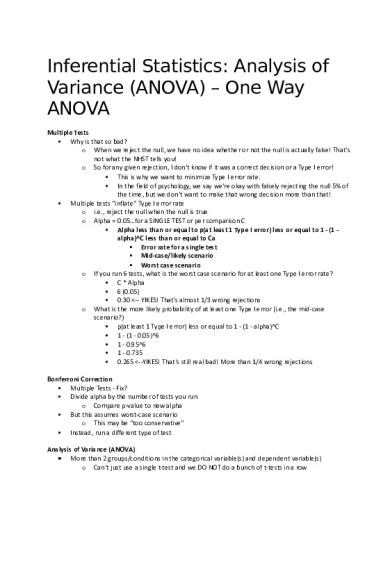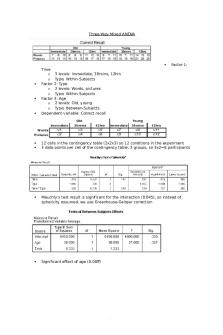10. Inferential Statistics. Analysis of Variance ( Anova) – One Way Anova PDF

| Title | 10. Inferential Statistics. Analysis of Variance ( Anova) – One Way Anova |
|---|---|
| Course | Statistics |
| Institution | Indiana University - Purdue University Indianapolis |
| Pages | 8 |
| File Size | 246.6 KB |
| File Type | |
| Total Downloads | 33 |
| Total Views | 170 |
Summary
This lecture discussed inferential statistics, including the analysis of variance (ANOVA), and one way ANOVA....
Description
Inferential Statistics: Analysis of Variance (ANOVA) – One Way ANOVA Multiple Tests Why is that so bad? o When we reject the null, we have no idea whether or not the null is actually false! That's not what the NHST tells you! o So for any given rejection, I don't know if it was a correct decision or a Type I error! This is why we want to minimize Type I error rate. In the field of psychology, we say we're okay with falsely rejecting the null 5% of the time, but we don't want to make that wrong decision more than that! Multiple tests "inflate" Type I error rate o i.e., reject the null when the null is true o Alpha = 0.05…for a SINGLE TEST or per comparison C Alpha less than or equal to p(at least 1 Type I error) less or equal to 1 - (1 alpha)^C less than or equal to Ca Error rate for a single test Mid-case/likely scenario Worst case scenario o If you run 6 tests, what is the worst case scenario for at least one Type I error rate? C * Alpha 6 (0.05) 0.30 0.05 or p < 0.05, so write that (whichever goes with the decision) o You can leave effect size and descriptive stats blank F(2,6) = 10.66 F(crit) = 5.14 o "We the null hypothesis that null hypothesis here, test-statistic (degrees of freedom) = _____, p = _____, effect size name = _____, (interpret what the conclusion means using descriptive stats, your verbal hypothesis, and "significant" or "not significant"> o We reject the null hypothesis that there is no effect relatability on ratings of purchasing LaCroix, F(2,6) = 10.66, p < 0.05, effect size = _____. There is a significant effect of relatability on ratings. The ratings are significantly different between relatability conditions. Relatability significantly affect the ratings of how likely participants are to purchase LaCroix Where 's the difference, thought? Do I go with both savvy social media AND traditional? Is savvy social media greater than traditional? o ANOVA does not tell you that! According to a post-hoc analysis called Schaffa's test, the only significant difference is between the influencer and savvy social media.
...
Similar Free PDFs

one way ANOVA tutorial
- 9 Pages

One-Way Anova - Lecture notes 10
- 4 Pages

One-Way Within-Subjects Anova
- 4 Pages

DSME 5- Analysis of Variance (ANOVA)
- 28 Pages

LAPORAN ANALISIS OF VARIANCE (ANOVA)
- 16 Pages

7) Three-Way Mixed Anova
- 3 Pages

Two-Way Analysis of Variance
- 5 Pages

Anova
- 5 Pages
Popular Institutions
- Tinajero National High School - Annex
- Politeknik Caltex Riau
- Yokohama City University
- SGT University
- University of Al-Qadisiyah
- Divine Word College of Vigan
- Techniek College Rotterdam
- Universidade de Santiago
- Universiti Teknologi MARA Cawangan Johor Kampus Pasir Gudang
- Poltekkes Kemenkes Yogyakarta
- Baguio City National High School
- Colegio san marcos
- preparatoria uno
- Centro de Bachillerato Tecnológico Industrial y de Servicios No. 107
- Dalian Maritime University
- Quang Trung Secondary School
- Colegio Tecnológico en Informática
- Corporación Regional de Educación Superior
- Grupo CEDVA
- Dar Al Uloom University
- Centro de Estudios Preuniversitarios de la Universidad Nacional de Ingeniería
- 上智大学
- Aakash International School, Nuna Majara
- San Felipe Neri Catholic School
- Kang Chiao International School - New Taipei City
- Misamis Occidental National High School
- Institución Educativa Escuela Normal Juan Ladrilleros
- Kolehiyo ng Pantukan
- Batanes State College
- Instituto Continental
- Sekolah Menengah Kejuruan Kesehatan Kaltara (Tarakan)
- Colegio de La Inmaculada Concepcion - Cebu







